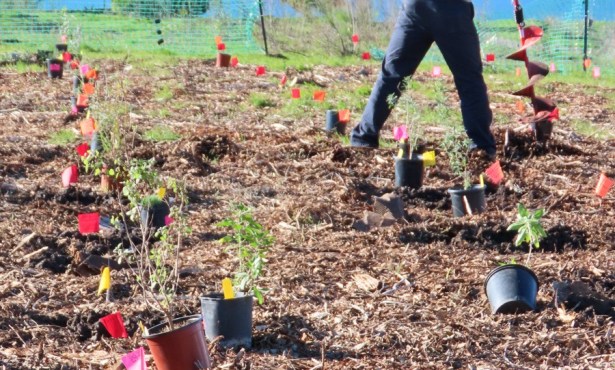Welcome to Wildfire Season
Jesusita Fire Erupts Tuesday in San Roque Canyon, Still Threatens Foothill Homes Today
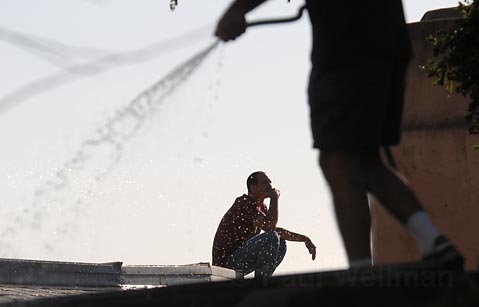
California’s wildfire season has begun, and Santa Barbara’s residents and firefighters are once again on the frontlines in the battle against surging flames and soaring smoke. Just before 2 p.m. on Tuesday, May 5, the Jesusita Fire erupted in San Roque Canyon, threatening foothill communities, forcing the evacuation of more than 1,000 homes, and triggering a full-frontal firefighting assault-involving air tankers, helicopters, and more than 800 individuals from city, county, state, and federal agencies-that continues today. With warm weather, variable humidity, and high winds shifting direction every few hours, the Jesusita Fire, which has already burned about 200 acres within a half-mile of neighborhoods, will likely remain a looming threat into the weekend.
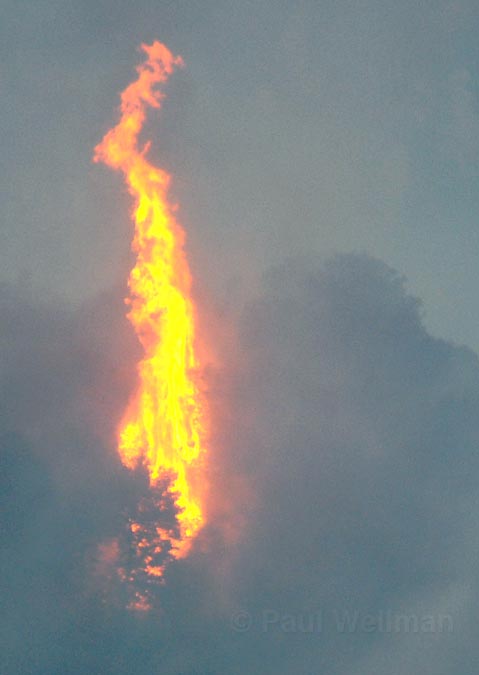
Since it’s fueled by thick brush that hasn’t burned since 1964, no one knows when the Jesusita Fire will be contained. What’s quite clear, however, is that wildfire season now stretches across the calendar in Santa Barbara County. Last year, the Tea Fire took down 230 structures in the S.B. and Montecito foothills in the supposedly fire-free month of November, a mere four months after the Gap Fire devoured nearly 10,000 acres of wilderness and farmland in July. The Jesusita Fire currently is consuming the unburned landscape between those two previous fires and, in a year when the winter months tallied a mere 53 percent of normal rainfall, Santa Barbara County could be in for many more wildfires yet.
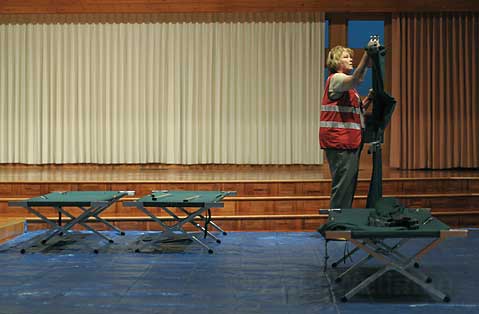
Thankfully, the previous fires have prepared both residents and firefighters to handle a Santa Barbara wildfire. Within minutes of smoke clouds being visible, fire crews from the city, county, and U.S. Forest Service were called into action, a command center was set up at the Cater Water Treatment Plant, a staging area was created at the Santa Barbara Mission, more state and federal agencies were requested to amass at Earl Warren Showgrounds, helicopters began dropping water on the growing flames, and scout planes were searching for ideal air tanker fire retardant drop zones. Evacuations were soon ordered for San Roque Canyon and Mission Canyon, with warnings later issued for everyone living near the foothills between La Cumbre and Sycamore Canyon roads.
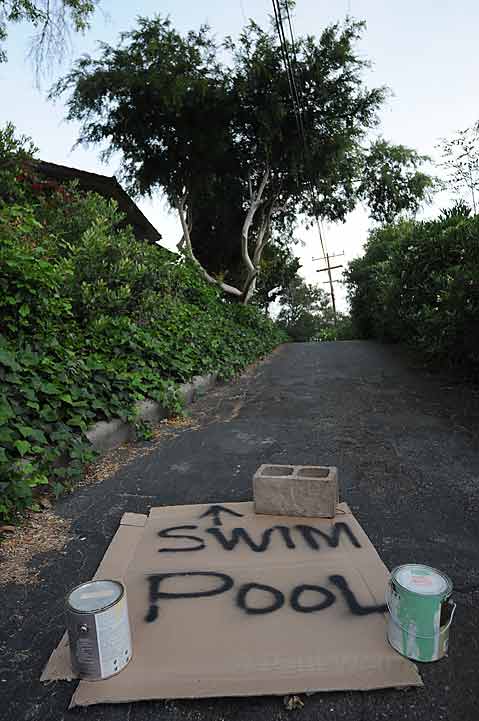
But even the best organized fight can only do so much. The weather rules the battle, and it changed rapidly on Tuesday, with high winds shifting repeatedly and warm temperatures throughout the day. But by nightfall, the temperatures had dropped and the 30-plus-miles-per-hour wind gusts became more sporadic. Come Wednesday morning, the fire hadn’t grown much and the smoke was settling. At a noon press conference on Wednesday, County Fire Chief Tom Franklin confirmed that the “fire has not progressed much at all,” thanks in part to high moisture levels in the burning brush. But Franklin also warned that the afternoon’s winds were expected to blow up to 60 miles per hour, and humidity could drop dangerously below 20 percent. By The Independent’s 2 p.m. print deadline on Wednesday, everyone was still holding their breath.
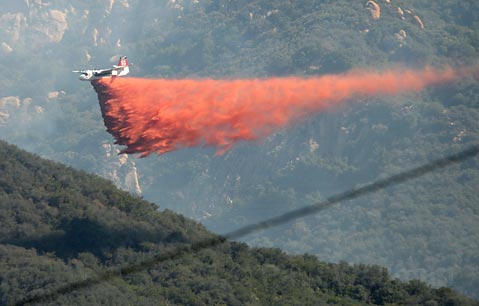
Because the blaze is burning such steep and wooded terrain, the firefighting initially was handled primarily from the air. Four helicopters repeatedly filled their buckets at Lauro Reservoir and dashed the surging orange flames throughout Tuesday afternoon. In the evening, two choppers equipped with night vision capabilities continued their rounds with refills at Santa Barbara Junior High, their constant hum a soothing noise to Santa Barbara residents all night. By Wednesday, five choppers were active.
However, both residents and firefighters were left wondering why there weren’t more and earlier air tanker drops of bright red fire retardant. It turns out that the U.S. Forest Service’s contract for firefighting support with the Santa Maria Airport had not been renewed in time. Fire season doesn’t officially start until May 15, so similar contracts across the state don’t go into effect until then, explained the U.S. Forest Service’s John Bridgewater. “All of us across California were caught by surprise,” he said. So the tankers-save for a couple refills in Santa Maria before the contract snafu was realized-had to refill in Porterville, an hour’s flight away, compared to the 15 minutes it takes to get to Santa Maria. Bridgewater said the Santa Maria Airport was opened for firefighting business by 11 a.m. on Wednesday.
The Wednesday drops allowed the first hand crews and dozer teams to face the fire head-on. “We’re engaging where we can engage,” said the city’s fire Battalion Chief Pat McElroy at the noon conference. Those efforts are creating the first discernible containment lines around the fire, but much hard work remains. “We have a lot of open line and a lot of work yet to do,” said County Fire Chief Franklin. Around 1 p.m., firefighters could be heard on a police scanner repeatedly asking for more air support if they wanted lines to continue being built.
Until the firefighters could start groundwork on Wednesday morning, the more than 14 assembled strike teams-more than 70 fire engines plus nearly 300 firefighters-had been checking evacuated homes for fire readiness and then waiting for the flames to come. The strike teams had been called on for “structure triage,” the battlefield protection of homes, one-by-one. Happily, that had yet to occur by Wednesday afternoon, but firefighters remained stationed at all vulnerable properties, ready to fight.
Residents of San Roque Canyon and Mission Canyon have also been preemptively commended for their preparations, which included clearing brush, cutting grasses to less than an inch tall, and ensuring that shrubs and trees are not too close together. However, wilderness literally swallows up properties in these areas, so even diligent preparation could prove futile during a wildfire.
Consequently, while many residents have stayed put in their homes, others heeded evacuation orders and could be seen leaving Tuesday with trucks and trailers packed with possessions. Some were never allowed back to the properties once the fire started, as traffic blockades at Foothill Road caused much anger for residents, some of whom needed to check on pets and elderly relatives. Those who did leave found refuge at friends’ homes and hotels such as the Peppertree Inn, which offered evacuees discounted rates. Others took advantage of the Red Cross shelter at Dos Pueblos High School. On Tuesday night, about 20 evacuees had filtered into the school. A crew from the yet-to-be-opened Best Buy in Goleta set up some televisions and a wireless Internet connection.
Tom Kasper, a Santa Barbara native who lives off Alamar Avenue near Foothill Road with his 82-year-old mother, said he had planned to stay in his home, but his mother wanted to leave, so they came to the shelter. “I grabbed a couple guitars and valuables, grabbed my mom’s medications, and some clothes,” he said. “Whatever’s gone is going to be gone.”
The Dos Pueblos gym can now accommodate about 200 people, but Kristiana Kocis of the Red Cross said they are prepared to house as many as 2,500 should the need arise. “The fewer people who come here, the better, because that means they have alternate plans,” she said. Around 30 of the county’s 1,300 Red Cross volunteers were working on Tuesday, preparing to staff the shelter and hand out water and snacks to firefighters.

Animals were also evacuated in droves, with small pets going to the S.B. Humane Society off Patterson Road. The society reported housing 25 dogs; 60 cats; 63 chickens, roosters, and chicks; one horse; and three cockatoos. Larger animals-including 20 horses, five mules, one donkey, one llama, one pig, three goats, four roosters, one raccoon, and 10 opossum-are at Earl Warren Showgrounds.
As of press time, there is no official word on the fire’s cause, although speculation on Tuesday was that it might be human-caused, since it started adjacent to the popular Jesusita Trail and gunshots initially were reported in the area. Some citizens believe that Tuesday’s Vandenberg Air Force Base rocket launch-which was over land rather than the ocean-may be related, but the base has flatly denied the allegations. Another man is claiming that he heard a transformer blow in the area, and believes that to be the cause. Anyone with information should call the tip hotline at 686-5074.



